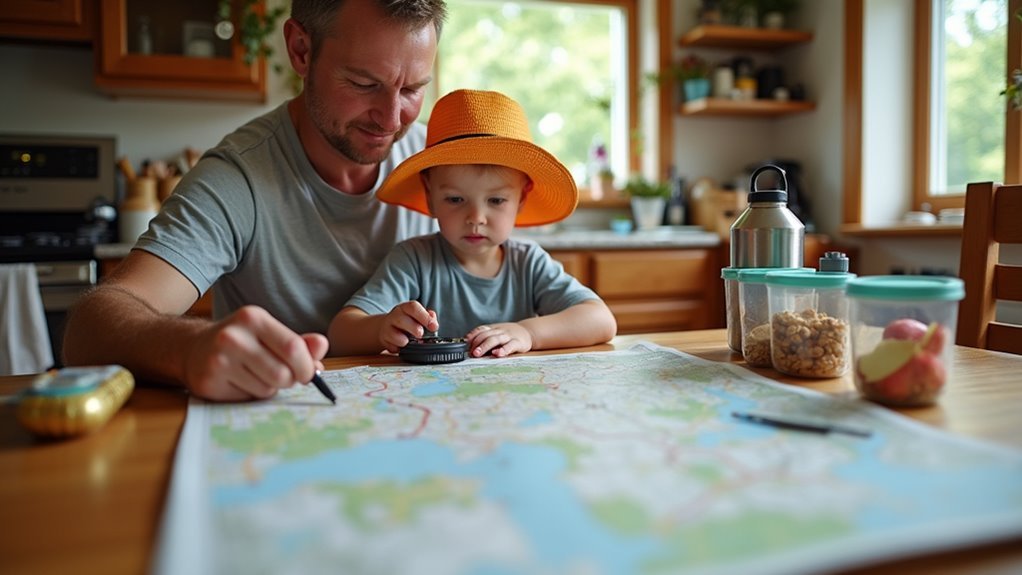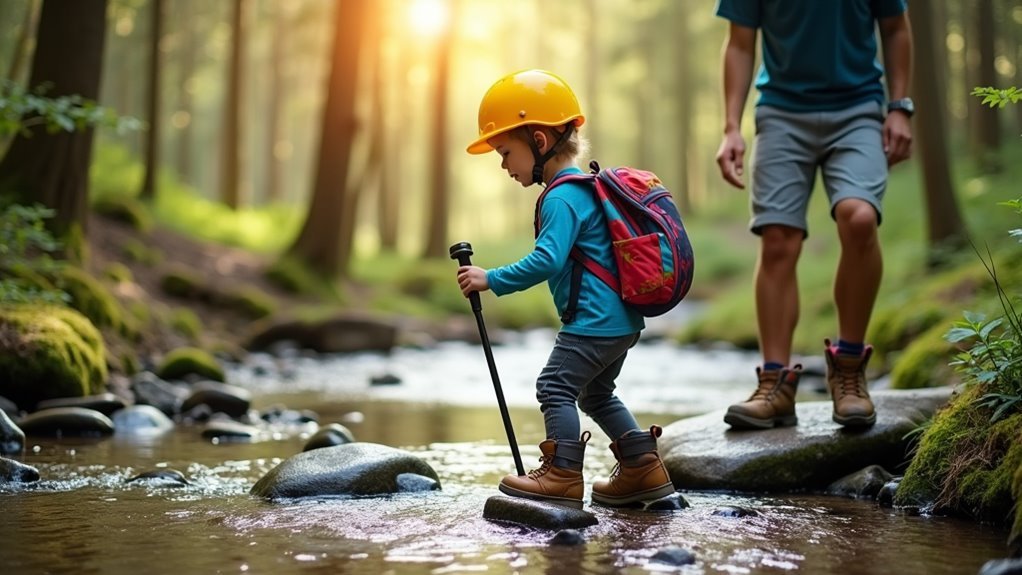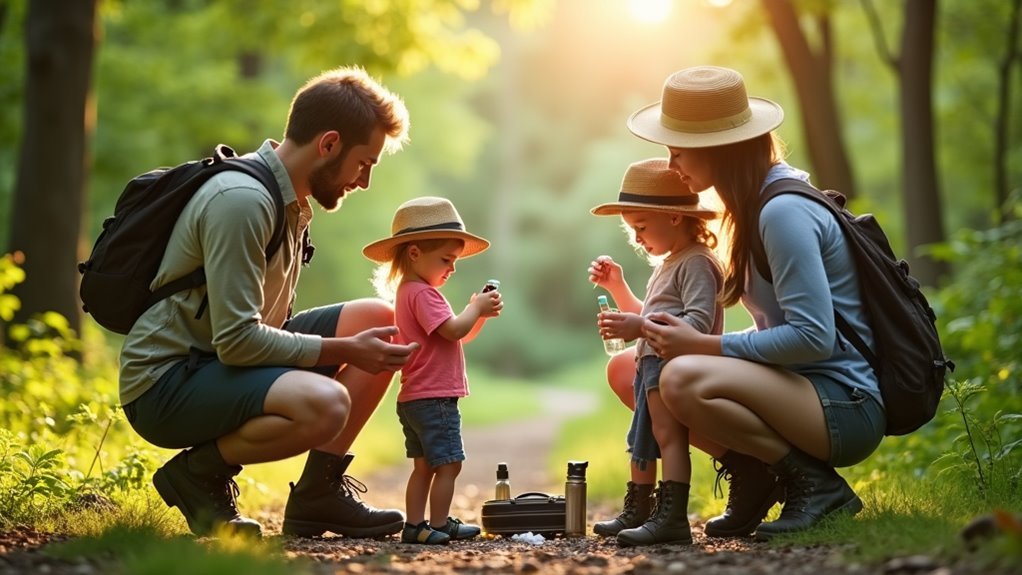Some of the links in this article may be affiliate links. If you make a purchase through these links, we may earn a small commission at no extra cost to you. Thank you.
While you might think geocaching with kids is risky, I’ve found it’s one of the safest outdoor activities when proper precautions are taken. I’ve been taking my niece and nephew on geocaching adventures for years, and I’ve picked up some essential safety strategies along the way. The key is balancing the thrill of the treasure hunt with smart preparation—something many parents overlook until they’re dealing with a scraped knee or lost child in the woods.
Essential Preparation Before the Hunt

How prepared are you for your next geocaching adventure with the kids?
I always start by downloading the official Geocaching app from Geocaching.com, which makes finding nearby treasures so much easier.
When selecting caches, I pay close attention to the difficulty and terrain ratings—trust me, a 1-star cache is perfect for beginners and young explorers!
I’ve learned that dressing kids in comfortable clothes suitable for hiking is essential.
And don’t forget to bring water, snacks, and a basic first-aid kit—you know how quickly little ones can get hungry or stumble on trails.
I always pack trinkets for trade that are equal or better than what we might take.
Oh, and I almost forgot—bring a pen for logbooks and hand sanitizer!
Teaching kids about maps and navigation really helps them stay aware of their surroundings.
Teaching Outdoor Awareness to Young Geocachers
I always teach my young geocachers to recognize wildlife hazards like poison ivy and snakes before we head out on our adventures.
When you’re focused on finding that hidden cache, it’s easy to miss environmental risks that could turn your fun day into an emergency room visit.
Wildlife Hazard Awareness
When venturing into the wild for geocaching adventures with your kids, wildlife awareness becomes an essential skill they’ll need.
I’m always reminding my little ones to be aware of their surroundings, especially when it comes to poison ivy with its telltale three-leaf clusters.
Always check exposed skin after your hunt – those itchy rashes aren’t the souvenirs you want!
I think staying on marked trails is non-negotiable when Geocaching with Kids.
Not only does this respect Leave No Trace principles, but it also reduces unexpected wildlife encounters.
I’ve found that making noise – clapping, singing, whatever works – scares away animals before you even see them.
And remember to keep your distance if you do spot wildlife.
Wait, let me be clear – at least 50 yards from bears and 25 from deer.
Environmental Risk Recognition
Teaching kids to recognize environmental risks while geocaching isn’t just about finding hidden treasures—it’s about nurturing their outdoor intuition.
I’ve found that showing children how to identify poison ivy and thorny plants in parks makes a huge difference during their treasure hunting adventures.
When I take young geocachers out, I always explain terrain ratings from 1 to 5 stars on cache listings—they’re like little warning signs for what to expect.
Looking for animal tracks or burrows is another skill that keeps kids safer while exploring.
CITO (Cache In Trash Out) events are perfect for teaching environmental responsibility.
I think these experiences help children understand why we should leave geocaching sites better than we found them.
In my experience, nothing builds environmental awareness faster than a child spotting pollution near their favorite cache.
Navigating Terrain Challenges Safely

I always check the terrain ratings before taking my kids geocaching, making sure to select 1- or 2-star caches with flat, easy paths they can handle.
You’ll want to dress them in proper hiking boots or trail shoes, as I’ve learned the hard way that sneakers just don’t cut it when the ground gets slippery or rocky.
When we’re out exploring, I’m constantly watching the weather app on my phone because nothing ruins a geocaching adventure faster than getting caught in unexpected rain without the right gear.
Assess Terrain Ratings First
Before heading out on any geocaching adventure with your kids, I always recommend checking the terrain ratings first.
The Geocaching app makes this super easy, showing ratings from 1-5 stars.
For young children, especially toddlers, I stick to 1-star rated caches which offer flat, easy paths with minimal risk of falls or fatigue.
When you follow the guidelines on terrain ratings, you’re basically setting yourself up for success.
I’ve found that using the app to find suitable caches helps me avoid those tricky 4 or 5-star locations that might require climbing or special equipment.
Even when using GPS units to find a cache, terrain difficulty matters more than distance.
Trust me, it’s much better to choose an appropriate terrain level than to end up carrying an exhausted child back to the car!
Proper Footwear Matters
The right footwear can make or break your geocaching adventure with kids.
When you go geocaching, sturdy hiking boots or closed-toe shoes with good traction are absolute must-haves.
I’ve seen too many geocache hunts cut short because someone forgot to bring proper shoes!
For kids under 10, I recommend lightweight waterproof options—they’ll thank you when crossing those unexpected streams.
Trust me, ankle support isn’t just a suggestion; it reduces sprains by nearly 50% on those tricky forested trails.
Check the terrain difficulty ratings before heading out.
Anything rated 3 or higher? Definitely boot territory.
While you’re remembering to Bring Your Own Pen and practice a little CITO (Cache In, Trash Out), don’t overlook what’s on your child’s feet—it’s literally their foundation for safe exploring.
Weather-Appropriate Preparations
Why does weather matter so much when you’re geocaching with kids?
Well, I’ve learned the hard way that weather can turn a fun road trip into a miserable experience in no time.
When I plan a CITO (Cache In, Trash Out) event or even night caching adventures, I always provide information about weather preparations to parents.
- Check forecasts before heading out—I think this saves time and prevents dangerous situations
- Dress kids in layers that can be adjusted as temperatures change
- Pack extra socks and rain gear—you’ll probably thank me later!
- Use weather apps to monitor conditions in real-time
- Teach children to recognize weather warning signs—maybe the darkening sky isn’t just pretty clouds
Preventing Health Risks During Geocaching Adventures

During your child’s geocaching adventures, maintaining good health should be just as important as finding the treasure. When your child finds a logbook to sign, encourage them to use their own pen rather than the one provided. If they want to take an item, remind them there are items to trade—just make sure they leave something of equal value for what they might take.
I’ve found that using a personal stamp with your child’s username is actually a clever alternative to handling shared pens. Here’s a quick guide to health safety:
| Health Measure | When to Use | Why It Matters |
|---|---|---|
| Hand Sanitizer | After cache handling | Kills germs immediately |
| Gloves | During cache searches | Prevents direct contact |
| Masks | In enclosed spaces | Reduces airborne risks |
| Early Morning Trips | Weekends especially | Fewer people, less exposure |
Technology Safety While Using GPS Devices
Beyond keeping healthy during geocaching adventures, managing technology becomes equally important for your child’s safety.
I’ve found that when you’ve just started geocaching, it’s essential to understand how GPS tools actually work.
When moving from cache to cache, remember that these devices aren’t perfect – they’ve got about a 30-foot margin of error, which could lead kids into trouble.
GPS devices can lead children astray with their 30-foot margin of error – always supervise their geocaching adventures.
Here are my top tips for tech safety:
- Supervise children closely when using GPS devices or apps
- Choose caches with 1-star difficulty ratings for beginners
- Teach kids to switch between map and compass views to prevent disorientation
- Use modern geocaching apps that allow real-time tracking
- Consider the $30/year premium membership for better maps before finding the next one
Handling Cache Contents Appropriately
Reaching into a geocache container can be a thrilling moment for kids, but it’s also where safety considerations become crucial. I always remind children to bring their own pen or stamp for signing logbooks—it’s such a simple way to avoid sharing germs!
| Safety Tip | Why It Matters | How To Do It |
|---|---|---|
| Use personal pen | Prevents germ spread | Bring a special “geo-pen” |
| Wear gloves/mask | Protects from germs | Pack disposables |
| Sanitize hands | Reduces illness risk | Carry pocket sanitizer |
When your kids want to trade items, make sure they understand the equal or greater value rule. Some larger caches contain small treasures, and it’s important that cache owners can trust visitors. I think teaching children to carefully reseal and hide the cache exactly as found builds good geocaching habits from the start.
Creating Family Geocaching Safety Rules
Why should your family create specific geocaching safety rules?
Well, when you’re out hunting for treasures with kids, having clear guidelines isn’t just helpful—it’s essential.
I’ve found that established family rules prevent accidents and make the experience enjoyable for everyone.
Plus, they teach kids responsibility while exploring.
Here are five family rules I recommend implementing:
- Discuss potential geocaching hazards like poison ivy or rough terrain before each hunt
- Require children to stay on marked trails and remain aware of their surroundings
- Enforce proper hygiene practices with hand sanitizer after handling cache items
- Practice environmental awareness through “Cache In, Trash Out” litter collection
- Provide adult supervision whenever children are using the geocaching app or exploring
These simple rules will keep your adventures fun and safe!
Frequently Asked Questions
How to Geocache With Kids?
I start with AdventurePrep by downloading the app and packing essentials. I create ThemedQuests and use KidMaps for navigation. We maintain FamilyLogs together and design InteractiveHunts appropriate for their age.
Is Geocaching Safe for Kids?
Yes, geocaching is safe for kids with my supervision. I’ll watch for water hazards, teach them to avoid poisonous plants, prevent navigation errors, and pack supplies for insect bites.
What Are the Three Main Rules of Geocaching?
I once found a cache in pristine condition! The three main geocaching rules are: swap guidelines (trade equal/greater value items), logging protocols (sign the logbook), and cache etiquette (leave everything as you found it).
What Is a Ghost Geocache?
I’d call ghost geocaches those spectral finds that once existed but were removed or archived. They linger as cache legends in databases, leading unsuspecting seekers on phantom hunts for archived mysteries that no longer exist.